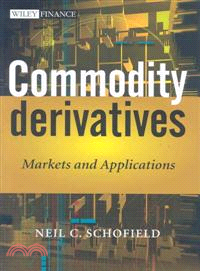COMMODITY DERIVATIVES - MARKETS AND APPLICATIONS
商品資訊
ISBN13:9780470019108
出版社:JOHN WILEY & SONS;LTD
作者:SCHOFIELD
出版日:2007/11/09
裝訂/頁數:精裝/336頁
規格:24.8cm*17.8cm*2.5cm (高/寬/厚)
定價
:NT$ 4750 元優惠價
:90 折 4275 元
若需訂購本書,請電洽客服 02-25006600[分機130、131]。
商品簡介
作者簡介
目次
相關商品
商品簡介
In Commodity Derivatives: Markets and Applications, Neil Schofield provides a complete and accessible reference for anyone working in, or studying commodity markets and their associated derivatives. Dealing primarily with over the counter structures, the book provides extensive coverage of both hard and soft commodities, including gold, crude oil, electricity, plastics, emissions and agriculturals.
Using structures unique to the individual market, each chapter includes an explanation of the commodity and an analysis of its physical market, discussion on the typical patterns of demand and supply and the main factors that will influence the price of the commodity, and the main products.
Each chapter focuses on how the products could be used along the physical supply chain and seeks to identify the main market risks and how they can be hedged. The book then brings into perspective how the structuring banks hedge their own resultant exposure and examines the attraction of OTC investment structures for the wholesale market.
Commodity Derivatives: Markets and Applications is essential reading for those wishing to learn about the main features of the commodity markets, the mechanics of derivatives, and how they are applied.
Using structures unique to the individual market, each chapter includes an explanation of the commodity and an analysis of its physical market, discussion on the typical patterns of demand and supply and the main factors that will influence the price of the commodity, and the main products.
Each chapter focuses on how the products could be used along the physical supply chain and seeks to identify the main market risks and how they can be hedged. The book then brings into perspective how the structuring banks hedge their own resultant exposure and examines the attraction of OTC investment structures for the wholesale market.
Commodity Derivatives: Markets and Applications is essential reading for those wishing to learn about the main features of the commodity markets, the mechanics of derivatives, and how they are applied.
作者簡介
Neil C. Schofield is currently the head of Financial Markets Training at Barclays Capital, where he has global responsibility for all aspects of the bank’s product-related training. As part of the job, he regularly delivers training on a wide range of subjects in commodities, fixed income, equity, foreign exchange and credit.
Prior to joining Barclays, he was a director at Chisholm Roth, a financial training company, where he delivered seminars to a blue-chip client base around the world. He has also worked in a training capacity for Chase Manhattan bank from 1988 to 1997. The author was appointed as a visiting fellow at ICMA Centre, Reading University, England in April 2007.
Prior to joining Barclays, he was a director at Chisholm Roth, a financial training company, where he delivered seminars to a blue-chip client base around the world. He has also worked in a training capacity for Chase Manhattan bank from 1988 to 1997. The author was appointed as a visiting fellow at ICMA Centre, Reading University, England in April 2007.
目次
Preface.
Acknowledgements.
About the Author.
1 An Introduction to Derivative Products.
1.1 Forwards and futures.
1.2 Swaps.
1.3 Options.
1.4 Derivative pricing.
1.4.1 Relative Value.
1.5 The spot–forward relationship.
1.5.1 Deriving forward prices: market in contango.
1.5.2 Deriving forward prices: market in backwardation.
1.6 The spot–forward–swap relationship.
1.7 The spot–forward–option relationship.
1.8 Put–call parity: a key relationship.
1.9 Sources of value in a hedge.
1.10 Measures of option risk management.
1.10.1 Delta.
1.10.2 Gamma.
1.10.3 Theta.
1.10.4 Vega.
2 Risk Management.
2.1 Categories of risk.
2.1.1 Defining risk.
2.1.2 Credit risk.
2.2 Commodity market participants: the time dimension.
2.2.1 Short-dated maturities.
2.2.2 Medium-dated maturities.
2.2.3 Longer-dated exposures.
2.3 Hedging corporate risk exposures.
2.4 A framework for analysing corporate risk.
2.4.1 Strategic considerations.
2.4.2 Tactical considerations.
2.5 Bank risk management.
2.6 Hedging customer exposures.
2.6.1 Forward risk management.
2.6.2 Swap risk management.
2.6.3 Option risk management.
2.6.4 Correlation risk management.
2.7 View-driven exposures.
2.7.1 Spot-trading strategies.
2.7.2 Forward trading strategies.
2.7.3 Single period physically settled "swaps."
2.7.4 Single or multi-period financially settled swaps.
2.7.5 Option-based trades: trading volatility.
3 Gold.
3.1 The market for gold.
3.1.1 Physical Supply Chain.
3.1.2 Financial Institutions.
3.1.3 The London gold market.
3.1.4 The price of gold.
3.1.5 Fixing the price of gold.
3.2 Gold price drivers.
3.2.1 The supply of gold.
3.2.2 Demand for gold.
3.2.3 The Chinese effect.
3.3 The gold leasing market.
3.4 Applications of derivatives.
3.4.1 Producer strategies.
3.4.2 Central Bank strategies.
4 Base Metals.
4.1 Base metal production.
4.2 Aluminium.
4.3 Copper.
4.4 London metal exchange.
4.4.1 Exchange-traded metal futures.
4.4.2 Exchange-traded metal options.
4.4.3 Contract specification.
4.4.4 Trading.
4.4.5 Clearing.
4.4.6 Delivery.
4.5 Price drivers.
4.6 Structure of market prices.
4.6.1 Description of the forward curve.
4.6.2 Are forward prices predictors of future spot prices?
4.7 Applications of derivatives.
4.7.1 Hedges for aluminium consumers in the automotive sector.
4.8 Forward purchase.
4.8.1 Borrowing and lending in the base metal market.
4.9 Vanilla option strategies.
4.9.1 Synthetic long put.
4.9.2 Selling options to enhance the forward purchase price.
4.9.3 "Three way."
4.9.4 Min–max.
4.9.5 Ratio min–max.
4.9.6 Enhanced risk reversal.
4.10 Structured option solutions.
4.10.1 Knock-out forwards.
4.10.2 Forward plus.
4.10.3 Bonus forward.
4.10.4 Basket options.
5 Crude Oil.
5.1 The value of crude oil.
5.1.1 Basic chemistry of oil.
5.1.2 Density.
5.1.3 Sulphur content.
5.1.4 Flow properties.
5.1.5 Other chemical properties.
5.1.6 Examples of crude oil.
5.2 An overview of the physical supply chain.
5.3 Refining crude oil.
5.3.1 Applications of refined products.
5.4 The demand and supply for crude oil.
5.4.1 Proved oil reserves.
5.4.2 R/P ratio.
5.4.3 Production of crude oil.
5.4.4 Consumption of crude oil.
5.4.5 Demand for refined products.
5.4.6 Oil refining capacity.
5.4.7 Crude oil imports and exports.
5.4.8 Security of supply.
5.5 Price drivers.
5.5.1 Macroeconomic issues.
5.5.2 Supply chain considerations.
5.5.3 Geopolitics.
5.5.4 Analysing the forward curves.
5.6 The price of crude oil.
5.6.1 Defining price.
5.6.2 The evolution of crude oil prices.
5.6.3 Delivered price.
5.6.4 Marker crudes.
5.6.5 Pricing sources.
5.6.6 Pricing methods.
5.6.7 The term structure of oil prices.
5.7 Trading crude oil and refined products.
5.7.1 Overview.
5.7.2 North Sea oil.
5.7.3 US crude oil markets.
5.8 Managing price risk along the supply chain.
5.8.1 Producer hedges.
5.8.2 Refiner hedges.
5.8.3 Consumer hedges.
6 Natural Gas.
6.1 How natural gas is formed.
6.2 Measuring natural gas.
6.3 The physical supply chain.
6.3.1 Production.
6.3.2 Shippers.
6.3.3 Transmission.
6.3.4 Interconnectors.
6.3.5 Storage.
6.3.6 Supply.
6.3.7 Customers.
6.3.8 Financial institutions.
6.4 Deregulation and re-regulation.
6.4.1 The US experience.
6.4.2 The UK experience.
6.4.3 Continental European deregulation.
6.5 The demand and supply for gas.
6.5.1 Relative importance of natural gas.
6.5.2 Consumption of natural gas.
6.5.3 Reserves of natural gas.
6.5.4 Production of natural gas.
6.5.5 Reserve to production ratio.
6.5.6 Exporting natural gas.
6.5.7 Liquefied natural gas.
6.6 Gas price drivers.
6.6.1 Definitions of price.
6.6.2 Supply side price drivers.
6.6.3 Demand side price drivers.
6.6.4 The price of oil.
6.7 Trading physical natural gas.
6.7.1 Motivations for trading natural gas.
6.7.2 Trading locations.
6.7.3 Delivery points.
6.8 Natural gas derivatives.
6.8.1 Trading natural gas in the UK.
6.8.2 On-the-day commodity market.
6.8.3 Exchange-traded futures contracts.
6.8.4 Applications of exchange-traded futures.
6.8.5 Over-the-counter natural gas transactions.
6.8.6 Financial/Cash-settled transactions.
7 Electricity.
7.1 What is electricity?
7.1.1 Conversion of energy sources to electricity.
7.1.2 Primary sources of energy.
7.1.3 Commercial production of electricity.
7.1.4 Measuring electricity.
7.2 The physical supply chain.
7.3 Price drivers of electricity.
7.3.1 Regulation.
7.3.2 Demand for electricity.
7.3.3 Supply of electricity.
7.3.4 Factors influencing spot and forward prices.
7.3.5 Spark and dark spreads.
7.4 Trading electricity.
7.4.1 Overview.
7.4.2 Markets for trading.
7.4.3 Motivations for trading.
7.4.4 Traded volumes: spot markets.
7.4.5 Traded volumes: forward markets.
7.5 Nord pool.
7.5.1 The spot market: Elspot.
7.5.2 Post spot: the balancing market.
7.5.3 The financial market.
7.5.4 Real-time operations.
7.6 United states of america.
7.6.1 Independent System Operators.
7.6.2 Wholesale markets in the USA.
7.7 United kingdom.
7.7.1 Neta.
7.7.2 UK trading conventions.
7.7.3 Load shapes.
7.7.4 Examples of traded products.
7.7.5 Contract volumes.
7.7.6 Contract prices and valuations.
7.8 Electricity derivatives.
7.8.1 Electricity forwards.
7.8.2 Electricity Swaps.
8 Plastics.
8.1 The chemistry of plastic.
8.2 The production of plastic.
8.3 Monomer production.
8.3.1 Crude oil.
8.3.2 Natural gas.
8.4 Polymerisation.
8.5 Applications of plastics.
8.6 Summary of the plastics supply chain.
8.7 Plastic price drivers.
8.8 Applications of derivatives.
8.9 Roles of the futures exchange.
8.9.1 Pricing commercial contracts.
8.9.2 Hedging instruments.
8.9.3 Source of supply/disposal of inventory.
8.10 Option strategies.
9 Coal.
9.1 The basics of coal.
9.2 The demand for and supply of coal.
9.3 Physical supply chain.
9.3.1 Production.
9.3.2 Main participants.
9.4 The price of coal.
9.5 Factors affecting the price of coal.
9.6 Coal derivatives.
9.6.1 Exchange-traded futures.
9.6.2 Over-the-counter solutions.
10 Emissions Trading.
10.1 The science of global warming.
10.1.1 Greenhouse gases.
10.1.2 The carbon cycle.
10.1.3 Feedback loops.
10.2 The consequences of global warming.
10.2.1 The Stern Report.
10.2.2 Fourth assessment report of the IPCC.
10.3 The argument against climate change.
10.4 History of human action against climate change.
10.4.1 Formation of the IPCC.
10.4.2 The Earth Summit.
10.4.3 The Kyoto Protocol.
10.4.4 From Kyoto to Marrakech and beyond.
10.5 Price drivers for emissions markets.
10.6 The EU emissions trading scheme.
10.6.1 Background.
10.6.2 How the scheme works.
10.6.3 Registries and logs.
10.6.4 National Allocation Plans (NAPs).
10.7 Emission derivatives.
11 Agricultural Commodities and Biofuels.
11.1 Agricultural markets.
11.1.1 Physical supply chain.
11.1.2 Sugar.
11.1.3 Wheat.
11.1.4 Corn.
11.2 Ethanol.
11.2.1 What is ethanol?
11.2.2 History of ethanol.
11.3 Price drivers.
11.3.1 Weather.
11.3.2 Substitution.
11.3.3 Investor activity.
11.3.4 Current levels of inventory.
11.3.5 Protectionism.
11.3.6 Health.
11.3.7 Industrialising countries.
11.3.8 Elasticity of supply.
11.3.9 Genetic modification.
11.4 Exchange-traded agricultural and ethanol derivatives.
11.5 Over-the-counter agricultural derivatives.
12 Commodities Within an Investment Portfolio.
12.1 Investor profile.
12.2 Benefits of commodities within a portfolio.
12.2.1 Return enhancement and diversification.
12.2.2 Asset allocation.
12.2.3 Inflation hedge.
12.2.4 Hedge against the US dollar.
12.3 Methods of investing in commodities.
12.3.1 Advantages and disadvantages.
12.4 Commodity indices.
12.4.1 Explaining the roll yield.
12.5 Total return swaps.
12.6 Structured investments.
12.6.1 Gold-linked notes.
12.6.2 Capital guaranteed structures.
12.6.3 Combination structures.
12.6.4 Non-combination structures.
12.6.5 Collateralised Commodity Obligations.
12.7 Analysing investment structures.
Glossary.
Notes.
Bibliography.
Index.
Acknowledgements.
About the Author.
1 An Introduction to Derivative Products.
1.1 Forwards and futures.
1.2 Swaps.
1.3 Options.
1.4 Derivative pricing.
1.4.1 Relative Value.
1.5 The spot–forward relationship.
1.5.1 Deriving forward prices: market in contango.
1.5.2 Deriving forward prices: market in backwardation.
1.6 The spot–forward–swap relationship.
1.7 The spot–forward–option relationship.
1.8 Put–call parity: a key relationship.
1.9 Sources of value in a hedge.
1.10 Measures of option risk management.
1.10.1 Delta.
1.10.2 Gamma.
1.10.3 Theta.
1.10.4 Vega.
2 Risk Management.
2.1 Categories of risk.
2.1.1 Defining risk.
2.1.2 Credit risk.
2.2 Commodity market participants: the time dimension.
2.2.1 Short-dated maturities.
2.2.2 Medium-dated maturities.
2.2.3 Longer-dated exposures.
2.3 Hedging corporate risk exposures.
2.4 A framework for analysing corporate risk.
2.4.1 Strategic considerations.
2.4.2 Tactical considerations.
2.5 Bank risk management.
2.6 Hedging customer exposures.
2.6.1 Forward risk management.
2.6.2 Swap risk management.
2.6.3 Option risk management.
2.6.4 Correlation risk management.
2.7 View-driven exposures.
2.7.1 Spot-trading strategies.
2.7.2 Forward trading strategies.
2.7.3 Single period physically settled "swaps."
2.7.4 Single or multi-period financially settled swaps.
2.7.5 Option-based trades: trading volatility.
3 Gold.
3.1 The market for gold.
3.1.1 Physical Supply Chain.
3.1.2 Financial Institutions.
3.1.3 The London gold market.
3.1.4 The price of gold.
3.1.5 Fixing the price of gold.
3.2 Gold price drivers.
3.2.1 The supply of gold.
3.2.2 Demand for gold.
3.2.3 The Chinese effect.
3.3 The gold leasing market.
3.4 Applications of derivatives.
3.4.1 Producer strategies.
3.4.2 Central Bank strategies.
4 Base Metals.
4.1 Base metal production.
4.2 Aluminium.
4.3 Copper.
4.4 London metal exchange.
4.4.1 Exchange-traded metal futures.
4.4.2 Exchange-traded metal options.
4.4.3 Contract specification.
4.4.4 Trading.
4.4.5 Clearing.
4.4.6 Delivery.
4.5 Price drivers.
4.6 Structure of market prices.
4.6.1 Description of the forward curve.
4.6.2 Are forward prices predictors of future spot prices?
4.7 Applications of derivatives.
4.7.1 Hedges for aluminium consumers in the automotive sector.
4.8 Forward purchase.
4.8.1 Borrowing and lending in the base metal market.
4.9 Vanilla option strategies.
4.9.1 Synthetic long put.
4.9.2 Selling options to enhance the forward purchase price.
4.9.3 "Three way."
4.9.4 Min–max.
4.9.5 Ratio min–max.
4.9.6 Enhanced risk reversal.
4.10 Structured option solutions.
4.10.1 Knock-out forwards.
4.10.2 Forward plus.
4.10.3 Bonus forward.
4.10.4 Basket options.
5 Crude Oil.
5.1 The value of crude oil.
5.1.1 Basic chemistry of oil.
5.1.2 Density.
5.1.3 Sulphur content.
5.1.4 Flow properties.
5.1.5 Other chemical properties.
5.1.6 Examples of crude oil.
5.2 An overview of the physical supply chain.
5.3 Refining crude oil.
5.3.1 Applications of refined products.
5.4 The demand and supply for crude oil.
5.4.1 Proved oil reserves.
5.4.2 R/P ratio.
5.4.3 Production of crude oil.
5.4.4 Consumption of crude oil.
5.4.5 Demand for refined products.
5.4.6 Oil refining capacity.
5.4.7 Crude oil imports and exports.
5.4.8 Security of supply.
5.5 Price drivers.
5.5.1 Macroeconomic issues.
5.5.2 Supply chain considerations.
5.5.3 Geopolitics.
5.5.4 Analysing the forward curves.
5.6 The price of crude oil.
5.6.1 Defining price.
5.6.2 The evolution of crude oil prices.
5.6.3 Delivered price.
5.6.4 Marker crudes.
5.6.5 Pricing sources.
5.6.6 Pricing methods.
5.6.7 The term structure of oil prices.
5.7 Trading crude oil and refined products.
5.7.1 Overview.
5.7.2 North Sea oil.
5.7.3 US crude oil markets.
5.8 Managing price risk along the supply chain.
5.8.1 Producer hedges.
5.8.2 Refiner hedges.
5.8.3 Consumer hedges.
6 Natural Gas.
6.1 How natural gas is formed.
6.2 Measuring natural gas.
6.3 The physical supply chain.
6.3.1 Production.
6.3.2 Shippers.
6.3.3 Transmission.
6.3.4 Interconnectors.
6.3.5 Storage.
6.3.6 Supply.
6.3.7 Customers.
6.3.8 Financial institutions.
6.4 Deregulation and re-regulation.
6.4.1 The US experience.
6.4.2 The UK experience.
6.4.3 Continental European deregulation.
6.5 The demand and supply for gas.
6.5.1 Relative importance of natural gas.
6.5.2 Consumption of natural gas.
6.5.3 Reserves of natural gas.
6.5.4 Production of natural gas.
6.5.5 Reserve to production ratio.
6.5.6 Exporting natural gas.
6.5.7 Liquefied natural gas.
6.6 Gas price drivers.
6.6.1 Definitions of price.
6.6.2 Supply side price drivers.
6.6.3 Demand side price drivers.
6.6.4 The price of oil.
6.7 Trading physical natural gas.
6.7.1 Motivations for trading natural gas.
6.7.2 Trading locations.
6.7.3 Delivery points.
6.8 Natural gas derivatives.
6.8.1 Trading natural gas in the UK.
6.8.2 On-the-day commodity market.
6.8.3 Exchange-traded futures contracts.
6.8.4 Applications of exchange-traded futures.
6.8.5 Over-the-counter natural gas transactions.
6.8.6 Financial/Cash-settled transactions.
7 Electricity.
7.1 What is electricity?
7.1.1 Conversion of energy sources to electricity.
7.1.2 Primary sources of energy.
7.1.3 Commercial production of electricity.
7.1.4 Measuring electricity.
7.2 The physical supply chain.
7.3 Price drivers of electricity.
7.3.1 Regulation.
7.3.2 Demand for electricity.
7.3.3 Supply of electricity.
7.3.4 Factors influencing spot and forward prices.
7.3.5 Spark and dark spreads.
7.4 Trading electricity.
7.4.1 Overview.
7.4.2 Markets for trading.
7.4.3 Motivations for trading.
7.4.4 Traded volumes: spot markets.
7.4.5 Traded volumes: forward markets.
7.5 Nord pool.
7.5.1 The spot market: Elspot.
7.5.2 Post spot: the balancing market.
7.5.3 The financial market.
7.5.4 Real-time operations.
7.6 United states of america.
7.6.1 Independent System Operators.
7.6.2 Wholesale markets in the USA.
7.7 United kingdom.
7.7.1 Neta.
7.7.2 UK trading conventions.
7.7.3 Load shapes.
7.7.4 Examples of traded products.
7.7.5 Contract volumes.
7.7.6 Contract prices and valuations.
7.8 Electricity derivatives.
7.8.1 Electricity forwards.
7.8.2 Electricity Swaps.
8 Plastics.
8.1 The chemistry of plastic.
8.2 The production of plastic.
8.3 Monomer production.
8.3.1 Crude oil.
8.3.2 Natural gas.
8.4 Polymerisation.
8.5 Applications of plastics.
8.6 Summary of the plastics supply chain.
8.7 Plastic price drivers.
8.8 Applications of derivatives.
8.9 Roles of the futures exchange.
8.9.1 Pricing commercial contracts.
8.9.2 Hedging instruments.
8.9.3 Source of supply/disposal of inventory.
8.10 Option strategies.
9 Coal.
9.1 The basics of coal.
9.2 The demand for and supply of coal.
9.3 Physical supply chain.
9.3.1 Production.
9.3.2 Main participants.
9.4 The price of coal.
9.5 Factors affecting the price of coal.
9.6 Coal derivatives.
9.6.1 Exchange-traded futures.
9.6.2 Over-the-counter solutions.
10 Emissions Trading.
10.1 The science of global warming.
10.1.1 Greenhouse gases.
10.1.2 The carbon cycle.
10.1.3 Feedback loops.
10.2 The consequences of global warming.
10.2.1 The Stern Report.
10.2.2 Fourth assessment report of the IPCC.
10.3 The argument against climate change.
10.4 History of human action against climate change.
10.4.1 Formation of the IPCC.
10.4.2 The Earth Summit.
10.4.3 The Kyoto Protocol.
10.4.4 From Kyoto to Marrakech and beyond.
10.5 Price drivers for emissions markets.
10.6 The EU emissions trading scheme.
10.6.1 Background.
10.6.2 How the scheme works.
10.6.3 Registries and logs.
10.6.4 National Allocation Plans (NAPs).
10.7 Emission derivatives.
11 Agricultural Commodities and Biofuels.
11.1 Agricultural markets.
11.1.1 Physical supply chain.
11.1.2 Sugar.
11.1.3 Wheat.
11.1.4 Corn.
11.2 Ethanol.
11.2.1 What is ethanol?
11.2.2 History of ethanol.
11.3 Price drivers.
11.3.1 Weather.
11.3.2 Substitution.
11.3.3 Investor activity.
11.3.4 Current levels of inventory.
11.3.5 Protectionism.
11.3.6 Health.
11.3.7 Industrialising countries.
11.3.8 Elasticity of supply.
11.3.9 Genetic modification.
11.4 Exchange-traded agricultural and ethanol derivatives.
11.5 Over-the-counter agricultural derivatives.
12 Commodities Within an Investment Portfolio.
12.1 Investor profile.
12.2 Benefits of commodities within a portfolio.
12.2.1 Return enhancement and diversification.
12.2.2 Asset allocation.
12.2.3 Inflation hedge.
12.2.4 Hedge against the US dollar.
12.3 Methods of investing in commodities.
12.3.1 Advantages and disadvantages.
12.4 Commodity indices.
12.4.1 Explaining the roll yield.
12.5 Total return swaps.
12.6 Structured investments.
12.6.1 Gold-linked notes.
12.6.2 Capital guaranteed structures.
12.6.3 Combination structures.
12.6.4 Non-combination structures.
12.6.5 Collateralised Commodity Obligations.
12.7 Analysing investment structures.
Glossary.
Notes.
Bibliography.
Index.
主題書展
更多
主題書展
更多書展今日66折
您曾經瀏覽過的商品
購物須知
外文書商品之書封,為出版社提供之樣本。實際出貨商品,以出版社所提供之現有版本為主。部份書籍,因出版社供應狀況特殊,匯率將依實際狀況做調整。
無庫存之商品,在您完成訂單程序之後,將以空運的方式為你下單調貨。為了縮短等待的時間,建議您將外文書與其他商品分開下單,以獲得最快的取貨速度,平均調貨時間為1~2個月。
為了保護您的權益,「三民網路書店」提供會員七日商品鑑賞期(收到商品為起始日)。
若要辦理退貨,請在商品鑑賞期內寄回,且商品必須是全新狀態與完整包裝(商品、附件、發票、隨貨贈品等)否則恕不接受退貨。
























